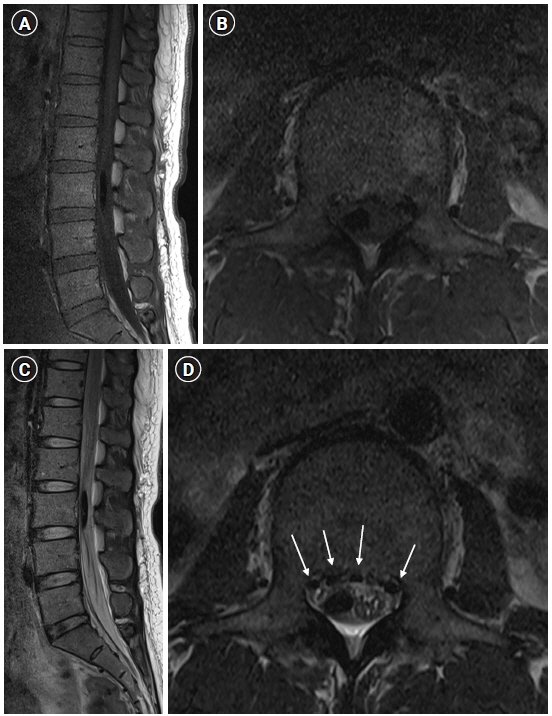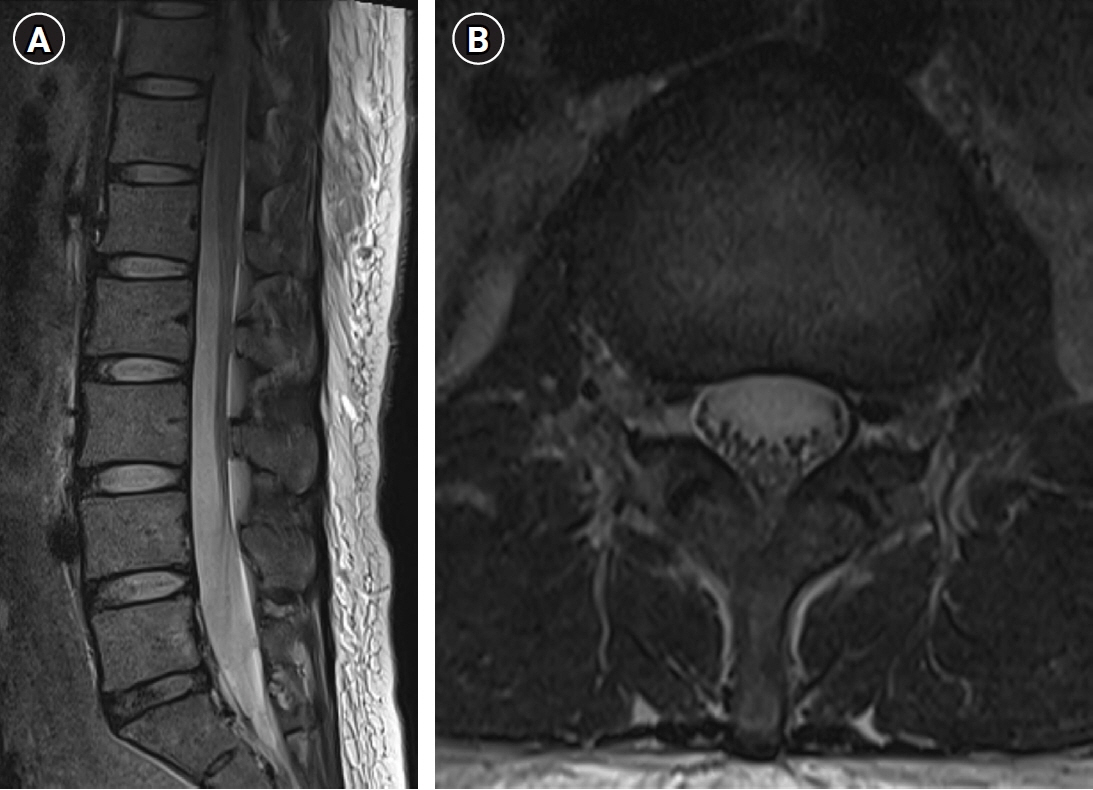Anesth Pain Med.
2024 Apr;19(2):150-155. 10.17085/apm.23105.
Unintended subdural anesthesia and subdural air bubbles after attempted epidural anesthesia in a patient undergoing cesarean section
- Affiliations
-
- 1Department of Anesthesiology and Pain Medicine, Kangnam Sacred Heart Hospital, Hallym University College of Medicine, Seoul, Korea
- KMID: 2555252
- DOI: http://doi.org/10.17085/apm.23105
Abstract
- Unintended subdural anesthesia accompanied by air bubbles compressing the cauda after attempting epidural anesthesia is rare. A 41-year-old pregnant woman was scheduled to undergo epidural anesthesia for cesarean section. After attempting epidural anesthesia, she experienced prolonged hypotension and recovery time, especially in the right extremity. Through magnetic resonance imaging (MRI) we found subdural air bubbles compressing the right side of the cauda equina in the L3 region. Thus, we considered unintended subdural anesthesia and performed conservative management with close observation. Her symptoms completely resolved within 24 h. Here, we report a case with various features of subdural anesthesia and subdural air bubbles compressing the cauda.
Figure
Reference
-
1. Stevens RA, Stanton-Hicks MD. Subdural injection of local anesthetic: a complication of epidural anesthesia. Anesthesiology. 1985; 63:323–6.2. Kalil A. Unintended subdural injection: a complication of epidural anesthesia--a case report. AANA J. 2006; 74:207–11.3. Yun JS, Kang SY, Cho JS, Choi JB, Lee YW. Accidental intradural injection during attempted epidural block - a case report-. Korean J Anesthesiol. 2011; 60:205–8.
Article4. Sanford C 2nd, Rodriguez RE, Schmidt J, Austin PN. Evidence for using air or fluid when identifying the epidural space. AANA J. 2013; 81:23–8.5. Norman D, Winkelman C, Hanrahan E, Hood R, Nance B. Labor epidural anesthetics comparing loss of resistance with air versus saline: does the choice matter? AANA J. 2006; 74:301–18.6. Lee MH, Han CS, Lee SH, Lee JH, Choi EM, Choi YR, et al. Motor weakness after caudal epidural injection using the air-acceptance test. Korean J Pain. 2013; 26:286–90.
Article7. Overdiek N, Grisales DA, Gravenstein D, Bosek V, Nishman R, Modell JH. Subdural air collection: a likely source of radicular pain after lumbar epidural. J Clin Anesth. 2001; 13:392–7.
Article8. Maronge L, Bogod D. Complications in obstetric anaesthesia. Anaesthesia. 2018; 73 Suppl 1:61–6.
Article9. Reina MA, De Leon Casasola O, López A, De Andrés JA, Mora M, Fernández A. The origin of the spinal subdural space: ultrastructure findings. Anesth Analg. 2002; 94:991–5.
Article10. Alshoubi A, Newhide D. Inadvertent subdural catheter placement: a rare complication in obstetric anesthesia. Cureus. 2022; 14:e27252.
Article11. Agarwal D, Mohtaf M, Tyagi A, Sethi AK. Subdural block and the anaesthetist. Anaesth Intensive Care. 2010; 38:20–5.
Article12. Shin H, Choi HJ, Kim C, Lee I, Oh J, Ko BS. Cardiac arrest associated with pneumorrhachis and pneumocephalus after epidural analgesia: two case reports. J Med Case Rep. 2018; 12:387.13. Lubenow T, Keh-Wong E, Kristof K, Ivankovich O, Ivankovich AD. Inadvertent subdural injection: a complication of an epidural block. Anesth Analg. 1988; 67:175–9.14. Hoftman NN, Ferrante FM. Diagnosis of unintentional subdural anesthesia/analgesia: analyzing radiographically proven cases to define the clinical entity and to develop a diagnostic algorithm. Reg Anesth Pain Med. 2009; 34:12–6.15. Nay PG, Milaszkiewicz R, Jothilingam S. Extradural air as a cause of paraplegia following lumbar analgesia. Anaesthesia. 1993; 48:402–4.
Article16. Barr DL, McDonald BS. Iatrogenic pneumocephalus following a cervical epidural steroid injection: a case report. Radiol Case Rep. 2021; 16:3875–8.
Article
- Full Text Links
- Actions
-
Cited
- CITED
-
- Close
- Share
- Similar articles
-
- A Case of Suspicious Subdural Block During Epidural Anesthesia for Cesarean Section
- Intrauterine fetal bradycardia after accidental administration of the anesthetic agent in the subdural space during epidural labor analgesia: A case report
- Severy Respiratory Depression and Intracranial Air after Epidural Morphine: Subdural or Epidural Injection?
- An anesthetic experience with cesarean section in a patient with vasovagal syncope: A case report
- Inadvertent Subdural Block Developed by Epidural Anesthesia



